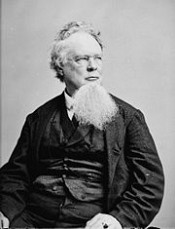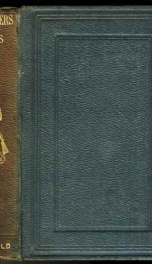Simms William Gilmore

William Gilmore Simms (April 17, 1806 – June 11, 1870) was a poet, novelist and historian from the American South whose novels achieved great prominence during the 19th century, with Edgar Allan Poe pronouncing him the best novelist America had ever produced.[1] In recent decades, though, Simms' novels have fallen out of favor, although he is still known among literary scholars as a major force in Antebellum literature.[2] He is also remembered for his strong support of slavery and for his opposition to Uncle Tom's Cabin, in response to which he wrote reviews and a novel.[3] Simms was born on April 17, 1806,[4] in Charleston, South Carolina,[5] of Scottish-Irish ancestors. His mother died during his infancy, and his father failed in business and joined Coffee's Indian fighters; as a result, Simms was brought up by his grandmother.[6] In his teen years, he worked as a clerk in a drug store but began to study law at the age of eighteen.[7] He married Anne Malcolm Giles in 1826.[8] The bar of Charleston admitted him to practice in 1827, though he soon abandoned this profession for literature.[9] He first wrote poetry at the age of eight, and in his 19th year he produced a monody on General Charles Cotesworth Pinckney (Charleston, 1825). Two years later, in 1827, Lyrical and Other Poems and Early Lays appeared. In 1828 he became a journalist as well as editor and part owner of the City Gazette, a role he held until 1832 when the publication failed.[5] Simms then devoted his attention entirely to writing and in rapid succession published Tile Vision of Cones, Cain, and Other Poems (1829); The Tricolor, or Three Days of Blood in Paris (1830); and his strongest poem, Atalantis, a Tale of the Sea (1832). Atalantis established his fame as an author.[10] His novel Martin Faber, the Story of a Criminal, an expanded version of an earlier short story called "The Confessions of a Murderer", was published in 1833[11] and made Simms known to a national audience.[12] Simms wrote a number of popular novels between 1830 and 1860, usually focusing on the pre-colonial and colonial periods of Southern history. These included such titles as The Yemassee (1835); The Lily and the Totem, or, The Huguenots in Florida (1850); Vasconselos (1853); and The Cassique of Kiawah (1859). Many critics believe The Cassique of Kiawah to be Simms’ best written work. At first, Southern readers, especially those in his home town of Charleston did not support Simms's work because he lacked an aristocratic background. Eventually, however, he was referred to as the Southern version of James Fenimore Cooper and Charleston residents invited him into their prestigious St. Cecilia Society.[5] Simms also wrote eight novels set in South Carolina during the American Revolutionary War, beginning with The Partisan (1835), which was likely Simms's most-read novel,[5] and Katherine Walton (1851). Other titles included Mellichampe (1836), The Kinsmen (1841), The Forayers (1855), Eutaw (1856), and Joscelyn (1867). Finally, Simms wrote ten novels dealing with the expansion into the frontier territory from Georgia to Louisiana, such as Richard Hurdis; or, the Avenger of Blood. A Tale of Alabama (1838) and Border Beagles: A Tale of Mississippi (1840). In 1852, Simms published The Tennessean’s Story, his only full-length work of Southern humor. He also wrote poetry and, in a letter to literary critic and poet Rufus Wilmot Griswold, Simms said that he was not interested in form as much as content, torn "between the desire to appear correct, and the greater desire to be original and true".[13] Simms was one of the best, and most respected, historians of his day. His History of South Carolina (1842) served for several generations as the standard school textbook on the state's history. He also wrote enormously popular biographies of Revolutionary War heroes Francis Marion, Nathanael Greene, and John Laurens, as well as John Smith and the Chevalier Bayard. Additionally, Simms was a popular lecturer on American history and accumulated one of the largest collections of Revolutionary War manuscripts. Unfortunately, most of this collection was lost when Sherman's army burned his home.[14] Simms is also remembered today for his strong support of slavery and for his opposition to Harriet Beecher Stowe's abolitionist novel Uncle Tom's Cabin, in response to which he wrote reviews and a book.[3] His Anti-Tom novel was The Sword and the Distaff. Even though The Sword and the Distaff came out only a few months after Stowe's novel, it contains a number of sections and discussions that are clearly debating Stowe's book and view of slavery. The novel focuses on the Revolutionary War and its aftermath through the lives of Captain Porgy and one of his slaves. Many of Simms other writings took a similar pro-slavery viewpoint.[15] Simms' book was one of between twenty and thirty Anti-Tom novels written after Stowe's book. As in Simms' book, these novels tended to feature a benign white patriarchal master and a pure wife, both of whom presided over child-like slaves in a benevolent extended-family-style plantation. Simms' novel was popular enough that it was reprinted in 1854 under the title Woodcraft.[16] In Simms' later years, he became part of the Southern plantation class and firmly supported slavery and Southern secession. During the American Civil War Simms espoused the side of the Secessionists in a weekly newspaper and suffered damage at the hands of the Federal troops when they entered Charleston. He served in the state House of Representatives in 1844–1846, after which he was defeated in the election for lieutenant-governor by only one vote.[17] The University of Alabama conferred on him the degree of LL.D. He died at his home at 13 Society Street in Charleston on June 11, 1870; he is buried in Magnolia Cemetery.[5] By the mid-1840s, Simms' fame for his novels was so great that Edgar Allan Poe declared Simms to be "The best novelist which this country has, on the whole, produced"[18] and "immeasurably the greatest writer of fiction in America".[19] Simms's story collection The Wigwam and the Cabin was singled out by Poe as "decidedly the most American of American books".[20] However, despite having achieved a very good literary reputation during his lifetime, today Simms' novels are, for the most part, out of print. Still, he is known among literary scholars as a major force in Antebellum literature.[2] A large bust of Simms is centrally located in Charleston's Battery Park.
do you like this author?
What readers are saying
What do you think? Write your own comment on this book!
write a commentWhat readers are saying
What do you think? Write your own comment on this author!
write a commentBook list

helen halsey or the swamp state of conelachita a tale of the borders
Series:
Unknown
Year:
Unknown
Raiting:
4/5
Show more
add to favoritesadd In favorites

grouped thoughts and scattered fancies a span classsearchtermspan class
Series:
Unknown
Year:
Unknown
Raiting:
5/5
Show more
add to favoritesadd In favorites

eutaw a sequel to the forayers or the raid of the dog days a tale of the rev
Series:
Unknown
Year:
Unknown
Raiting:
4/5
Show more
add to favoritesadd In favorites
Book list

helen halsey or the swamp state of conelachita a tale of the borders
Series:
Unknown
Year:
Unknown
Raiting:
4/5
Show more
add to favoritesadd In favorites

grouped thoughts and scattered fancies a span classsearchtermspan class
Series:
Unknown
Year:
Unknown
Raiting:
5/5
Show more
add to favoritesadd In favorites

eutaw a sequel to the forayers or the raid of the dog days a tale of the rev
Series:
Unknown
Year:
Unknown
Raiting:
4/5
Show more
add to favoritesadd In favorites

egeria or voices of thought and counsel for the woods and wayside
Series:
Unknown
Year:
Unknown
Raiting:
5/5
Originally published in 1853. This volume from the Cornell University Library's print collections was scanned on an APT BookScan and converted to JPG 2000 format by Kirtas Technologies. All titles scanned cover to cover and pages may include marks notations and other marginalia present in the original volume.
Show more
add to favoritesadd In favorites

carl werner an imaginative story with other tales of imagination volume 1 2
Series:
Unknown
Year:
Unknown
Raiting:
4/5
Show more
add to favoritesadd In favorites

border beagles a tale of mississippi
Series:
Unknown
Year:
Unknown
Raiting:
4/5
Purchase of this book includes free trial access to www.million-books.com where you can read more than a million books for free. This is an OCR edition with typos. Excerpt from book: CHAPTER IV. THE WHY AND THE VVUEREKOBK. "It UBt8 Of rank injustice, and some other end Time will discover; and yet our grace is bound To hear his accusation confirmed, Or hunt this spotted panther to his ruin."Shout The stranger was one of whom the reader has already heard. The quick eye of Vernon distinguished his friend at a glance, nor was that of the other less observant. The warmth of theii embrace, when they met, spoke for a deep mutual regard be tween the two, not only superior to that which belongs to ordinary friendships, but something more than could be expected to appear in the case of persons so unequal in years. Mr. Carter could not have been less than forty-five; a tall, well-made man, with a fine, full, but dark countenance; an eye, black and lively, but of benevolent expression; and a look of amenity and kindness which denoted a degree of soberness and subdued thought, in which the buoyant spirits of the youth of tweuty- five, could scarcely find much that was congenial. Vernon could not have been much more than twenty-five; his temperament was evidently lively, if not rash; and good humor and a playful spirit, seemed to predominate in his disposition. The gravity, the almost sadness, of Carter's countenance, wa§ unreflected in his own ; and yet, it may be added, the sympathy was quite as close between them, as could be hoped for under any circumstances; and whatever might be the difference of their moods and wishes, under the influence of unequal ages, there was none of that exacting severity, on the part of Carter or of that distaste to discipline, on the side of Veruon, which endanger the relation. If Carter was grave, even to mclancholy, he was, at the same time, benign and indulgent. Ha could make allowance for the impatience of youth,... --This text refers to the Paperback edition.
Show more
add to favoritesadd In favorites

beauchampe or the kentucky tragedy a sequel to charlemons
Series:
Unknown
Year:
Unknown
Raiting:
4/5
Show more
add to favoritesadd In favorites

beauchampe or the kentucky tragedy a sequel to charlemont
Series:
Unknown
Year:
Unknown
Raiting:
5/5
Show more
add to favoritesadd In favorites

as good as a comedy or the tennesseans story microform
Series:
Unknown
Year:
Unknown
Raiting:
5/5
Show more
add to favoritesadd In favorites

Guy Rivers: A Tale of Georgia
Series:
Unknown
Year:
Unknown
Raiting:
5/5
American Revolution. 502 pp.
Show more
add to favoritesadd In favorites

Confession, or, the Blind Heart; a Domestic Story
Series:
Unknown
Year:
Unknown
Raiting:
3/5
Short excerpt: The pains and penalties of folly are not necessarily death. They were in old times, perhaps, according to the text, and he who kept not to himself the secrets of his silly heart was surely crucified or burnt. --This text refers to an alternate Paperback edition.
Show more
add to favoritesadd In favorites

Charlemont; Or, the Pride of the Village. a Tale of Kentucky
Series:
Unknown
Year:
Unknown
Raiting:
3/5
This volume is produced from digital images created through the University of Michigan University Library's preservation reformatting program. The Library seeks to preserve the intellectual content of items in a manner that facilitates and promotes a variety of uses. The digital reformatting process results in an electronic version of the text that can both be accessed online and used to create new print copies. This book and thousands of others can be found in the digital collections of the University of Michigan Library. The University Library also understands and values the utility of print, and makes reprints available through its Scholarly Publishing Office.
Show more
add to favoritesadd In favorites
What readers are saying
What do you think? Write your own comment on this author!
write a commentif you like Simms William Gilmore try:
readers also enjoyed
What readers are saying
What do you think? Write your own comment on this author!
write a commentGenre
if you like Simms William Gilmore try:
readers also enjoyed
Do you want to exchange books? It’s EASY!
Get registered and find other users who want to give their favourite books to good hands!


